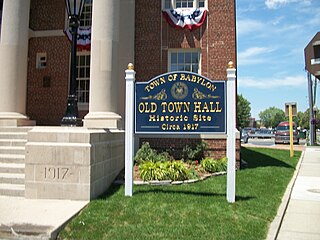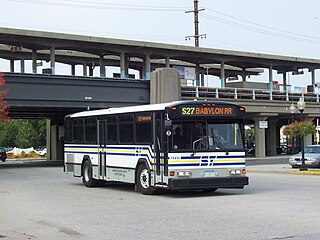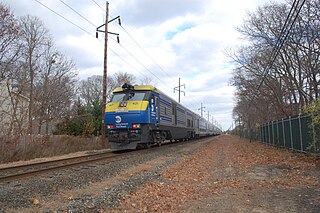Related Research Articles

Melville is a hamlet and census-designated place (CDP) in the Town of Huntington in Suffolk County, on Long Island, in New York, United States. The population was 19,284 at the time of the 2020 census.

Babylon is a village within the Town of Babylon in Suffolk County, New York. The population was 12,188 at the 2020 census. It is located approximately 25 miles (40 km) from New York City at the Queens border and approximately 33 miles (53 km) from Manhattan.

The Town of Babylon is one of ten towns in Suffolk County, New York, United States. Its population was 218,223 as of the 2020 census. Parts of Jones Beach Island, Captree Island and Fire Island are in the southernmost part of the town. It borders Nassau County to the west and the Atlantic Ocean to the south. At its westernmost point, it is about 20 miles (32 km) from New York City at the Queens border, and about 30 miles (48 km) from Manhattan. The village of Babylon is also within the town.

Copiague is a station on the Babylon Branch of the Long Island Rail Road, located in Copiague, New York. The station is located on Marconi Boulevard and Great Neck Road, one block north of Oak Street.

The Babylon Branch is a rail service operated by the Long Island Rail Road in the U.S. state of New York. The term refers to the trains serving Montauk Branch stations from Valley Stream east to Babylon; in other words, the Babylon Branch is a rail service rather than an actual track. The electrification of the Montauk Branch ends east of the Babylon station, so the Babylon Branch is mostly served by electric trains.

New York State Route 110 (NY 110) is a major north–south state highway along the western border of Suffolk County, New York. It runs between the village of Amityville in the town of Babylon and Halesite in the town of Huntington. NY 110 comes close to the Nassau County line several times in the town of Babylon, which is only surpassed by NY 108 in distance to the county line for a state highway.

The Babylon station is a station on the Long Island Rail Road in the village of Babylon, New York at Railroad Avenue west of Deer Park Avenue. It is on the Montauk Branch and is the eastern terminus of the Babylon Branch service. To the west is the junction with the Central Branch, which heads northwest to join the Main Line at Bethpage Interlocking southeast of the Bethpage station. Babylon station is elevated with two island platforms and is wheelchair accessible through elevator access. The electrified portion of the Montauk Branch ends east of the station.
The Suffolk Traction Company is a former streetcar system in Suffolk County, New York. It operated primarily between Patchogue and Holtsville, but also included a route that served Blue Point, Bayport, and Sayville. It was opened in 1909 and ceased operations in 1919.
Vincent Francis Seyfried was an American historian of Long Island. His work between 1950 and 2010 includes eleven books on trolley systems in Queens and Long Island, twelve books on areas of Queens, a seven-volume set on the Long Island Rail Road, and a history of the founding of Garden City, where he was Village Historian from 1987 to 2006. He provided many entries on Queens history for The Encyclopedia of New York City (1995).

Sayville is a station on the Montauk Branch of the Long Island Rail Road in the village of Sayville, New York, on Depot Street between Greeley Avenue and Railroad Avenue. Ferries to Fire Island board from a port south of the station.

Amityville is the westernmost station on the Babylon Branch of the Long Island Rail Road in Suffolk County. It is located on John Street in Amityville, New York, but the official description of its location is not as precise. The MTA describes the station as being located on John Street between Sunrise Highway and NY 27A west of NY 110. John Street is located between Sterling Place and West Oak Street.

Northport is a station on the Port Jefferson Branch of the Long Island Rail Road. It is located at the corner of Larkfield Road and Bellerose Avenue, north of Suffolk CR 11 in East Northport, Suffolk County, New York.
Central Railroad of Long Island was built on Long Island, New York, by Alexander Turney Stewart, who was also the founder of Garden City. The railroad was established in 1871, then merged with the Flushing and North Side Railroad in 1874 to form the Flushing, North Shore and Central Railroad. It was finally acquired by the Long Island Rail Road in 1876 and divided into separate branches. Despite its short existence, the CRRLI had a major impact on railroading and development on Long Island.

Holtsville was a station stop on the Greenport Branch of the Long Island Rail Road. It was located off the southeast corner of the Waverly Avenue grade crossing on the south side of the tracks between Long Island Avenue and Furrows Road in Holtsville, New York.

Bayport was a station stop along the Montauk Branch of the Long Island Rail Road. It was located on Railroad Street between Oakwood and Snedecor Avenues in Bayport, New York, and was the easternmost station along the Montauk Branch in the Town of Islip.
The Huntington Railroad was established on July 19, 1890 with a trolley line between Huntington Village and Halesite on Long Island, New York. It was eventually extended to Huntington Railroad Station, then along what is today mostly NY 110 through Melville, Farmingdale, and as far south as the docks of Amityville. Huntington Railroad had only one line throughout its history, although the length varied through the years.

Northport Traction Company was a trolley service in the Town of Huntington in New York. It ran from 1902 to 1924 and served East Northport and Northport, New York. The company only had one line throughout its history which ran from Northport to Northport Harbor, at what is today Cow Harbor Park. Unlike Huntington Railroad to the west, Northport Traction Company never expanded beyond either Northport or East Northport, and no record exists of any proposal to do so.
The Manhattan and Queens Traction Company, also known as the Manhattan and Queens Transit Company, was a streetcar company operating in Manhattan and Queens County, New York between 1913 and 1937.
References
- ↑ "The 100th Anniversary of the (Amityville-Babylon) Trolley Line". Amityville Historical Society and Lauder Museum. Archived from the original on March 15, 2012.
- ↑ Meyers, Stephen L. (2006). "Five: The South Shore Lines and a Surprise". Images of Rail: Lost Trolleys of Queens and Long Island.